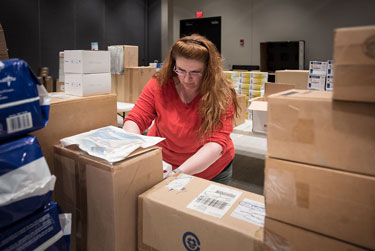The massive public health response to the COVID-19 pandemic forced health departments to limit or suspend other essential public health services, which could impact U.S. health for years to come, according to a recent study.
Published in October in PLOS One, the study found that critical services such as health education and promotion and outbreak investigations not related to the pandemic suffered significantly as workers shifted to pandemic control and containment in 2020.
“We definitely knew we’d see big changes in people who were not already working in infectious diseases or emergency preparedness,” said study co-author Jennifer Horney, PhD, MPH, professor and founding director of the University of Delaware’s Epidemiology Program. “But one surprise was the extent of the reorientation of anyone in any other kind of outbreak or infectious disease setting, such as people working on sexually transmitted diseases or foodborne outbreaks, which are really critical roles.”
The study, which was based on a survey of almost 300 public health practitioners from 31 states and Washington, D.C., found many staff were reassigned to COVID-19 work, draining expertise in other areas. Between January and fall 2020, survey respondents reported a 39% reduction in expertise related to chronic disease, a 42% reduction for maternal and child health, a 28% reduction for substance abuse, a 27% reduction for environmental health, a 37% reduction for injury control and prevention, and a 47% decrease for programs focused on HIV, STDs, tuberculosis, social epidemiology and health disparities, among other topics.
“Other infectious diseases didn’t stop happening because of COVID-19,” Horney told The Nation’s Health. “We also still need to quench other outbreaks before they spread.”
Researchers found that more than half of respondents working in infectious disease, substance abuse and preparedness, as well as nearly two-thirds of those in informatics and vital statistics, were reassigned to other content areas during the pandemic. Areas with the greatest proportion of workers shifted to COVID-19 response included occupational health, chronic disease and injury.
Overall, the total number of survey respondents working in infectious disease and preparedness remained constant, while no content areas except for COVID-19 experienced a rise in staff numbers.
“The provision of essential public health services has often been anecdotally described as invisible when working well,” researchers wrote. “However, as the COVID-19 pandemic is clearly demonstrating, current policies related to funding and professional development of the U.S.’s public health workforce are inadequate for supporting an effective response to a public health emergency while maintaining the provision of essential population health services.”
The study also surveyed respondents about their work hours, finding a significant increase in overtime. Horney, an APHA member, noted that another study she co-authored — published in November in Health Security — found that some public health workers faced an “overwhelming” backlog of work after returning from COVID-19 duty.
“It was as if they hadn’t been to work in 18 months,” Horney told The Nation’s Health. “As stressful as it was to shift to COVID-19 and put in so many more hours, returning to their original roles that had basically been neglected for so long was also really difficult.”
Going forward, Horney said both studies point to the need to invest in overall public health capacity so agencies can respond to urgent challenges while also maintaining essential functions. In the short-term, she said she worries that dealing with another surge of COVID-19 could push even more practitioners out of the field.
“The public health sector is no different than any other in trying to figure out what the new normal looks like,” Horney said.
— Kim Krisberg
Margaret Hibbs, a regional preparedness coordinator for the Kentucky Department of Public Health, sorts medical supplies in Louisville, Kentucky, in April 2020. Photo by Dale Greer, courtesy U.S. Air National Guard, via Flickr